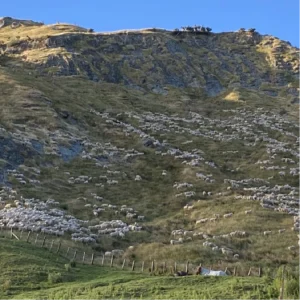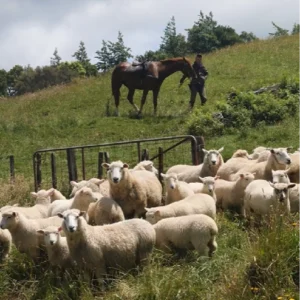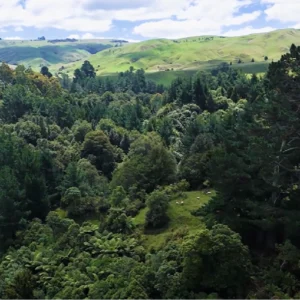Aerial Station: Farming in Tune with Nature
No one is quite sure exactly how Aerial Station got its name. But with the highest point on the property sitting at approximately 3000 feet above sea level, it’s fair to assume its elevation may have had something to do with it.
This country is not for the faint of heart. This is quintessential steep, East Coast hill country. Situated about an hour’s drive  on the one road leading north out of Gisborne on the East Coast of New Zealand’s North Island, Aerial Station consists of approximately 2,500 acres and has been in the Tombleson family for almost 50 years. Winding your way along the Waipaoa River on the way to Aerial Station it is evident this is highly productive country; a hive of activity of harvesting squash, maize and preparing some of the region’s finest grapes for imminent harvest. As you start to climb, the productive flats give way to stunning, jagged clifftops and mountain ranges, amongst which Aerial Station is nestled.
on the one road leading north out of Gisborne on the East Coast of New Zealand’s North Island, Aerial Station consists of approximately 2,500 acres and has been in the Tombleson family for almost 50 years. Winding your way along the Waipaoa River on the way to Aerial Station it is evident this is highly productive country; a hive of activity of harvesting squash, maize and preparing some of the region’s finest grapes for imminent harvest. As you start to climb, the productive flats give way to stunning, jagged clifftops and mountain ranges, amongst which Aerial Station is nestled.
Fraser and wife Jaime bought the majority of Aerial Station 5 years ago from Fraser’s parents, whilst leasing the remainder. The property is remote, to say the least, there is no popping down to the local store to pick up supplies! Sitting under a near vertical cliff face, the woolshed and homestead are the central hub of the property. In an effort to work in tune with nature, Aerial Station installed solar panels on the roof of the woolshed. This is a common theme at Aerial Station.
In such an unforgiving, remote setting you have little choice but to work with what you’ve got. Which in large part is the reason the majority of mustering and farm work is conducted on horseback. Horses play an integral role at Aerial Station, a philosophy engrained by Fraser’s father Warwick and now carried on by the next generation. Fraser, who rode competitively, tells Atkins Ranch “People think it is slower or less efficient working on horseback, however given the topography we can cover more ground on horseback.” There are further benefits to working horses, to a great degree horses are self-driving, allowing the farmer to survey the territory around them opposed to having to pay attention to narrow farm tracks while driving.
 Sitting down with the Tomblesons for a coffee and freshly baked banana cake, you can’t help but get a sense this is an enterprising young family. Jaime is the founder of a successful jewellery brand, Jaime Lucinda Jewellery, balancing farm life, and the mother of three children under the age of 5. Life at Aerial Station is busy. But they wouldn’t have it any other way.
Sitting down with the Tomblesons for a coffee and freshly baked banana cake, you can’t help but get a sense this is an enterprising young family. Jaime is the founder of a successful jewellery brand, Jaime Lucinda Jewellery, balancing farm life, and the mother of three children under the age of 5. Life at Aerial Station is busy. But they wouldn’t have it any other way.
One thing you won’t find on Aerial Station is any cropping. Again, this is a demonstration of working in tune with nature. Rather, the 3,700 head of sheep on Aerial Station are treated to a nutrient rich, natural mixture of the best grasses in the country. Fraser is a firm advocate of limiting the number of inputs into his world-class lamb, instead letting Mother Nature do her thing. This less intensive, low input plays an integral role in producing some of the world’s finest lamb.
Fraser and Jaime are now reaping the benefits of Fraser’s mother’s hard work many years ago. Fraser recalls being dragged out, somewhat reluctantly, as a teenager to go and plant trees on the property. They say a mother always knows best, and in this case, they couldn’t be more right. The stands of native and exotic trees planted years ago now play an important role at Aerial Station, providing not only habitat for native flora and fauna, but shelter and wind breaks for the animals.
One of the first things Fraser and Jaime did when they took the reins, was to fence off roughly 120 acres of native bush. And they’re not stopping there. Fraser believes in the right tree in the right place, which in this steep, erosion prone east coast hill country is once again another example of working with Mother Nature, not against her.
 The future is bright at Aerial Station, Fraser and Jaime are an enterprising young couple making the most of the phenomenal privilege bestowed on them in running Aerial Station. Fraser reminds us of the adage used by the New Zealand All Blacks “You never own the jersey; you are only ever borrowing it”. You get a strong sense of this spirit of guardianship when speaking with the couple as they talk about their plans for the future.
The future is bright at Aerial Station, Fraser and Jaime are an enterprising young couple making the most of the phenomenal privilege bestowed on them in running Aerial Station. Fraser reminds us of the adage used by the New Zealand All Blacks “You never own the jersey; you are only ever borrowing it”. You get a strong sense of this spirit of guardianship when speaking with the couple as they talk about their plans for the future.
But for now, there are jobs to be done.